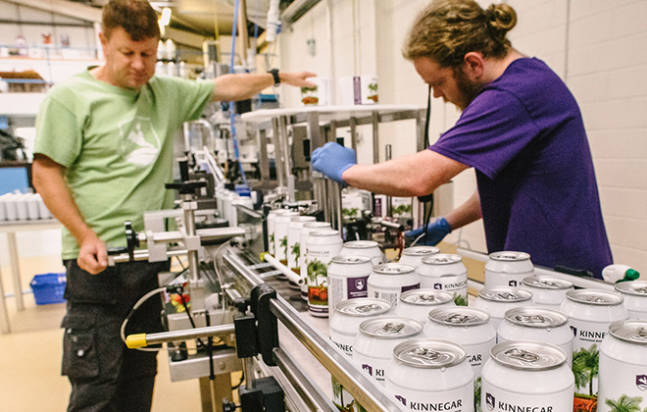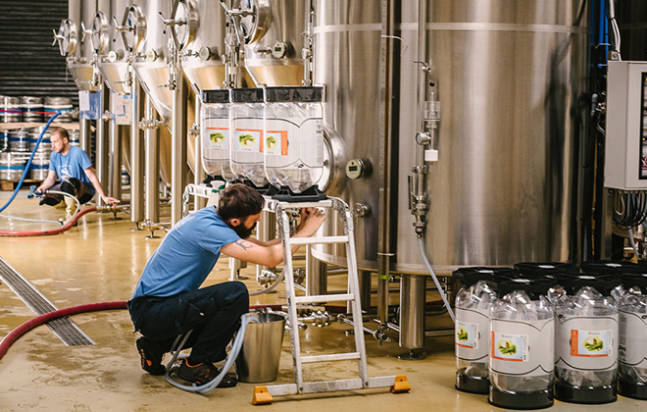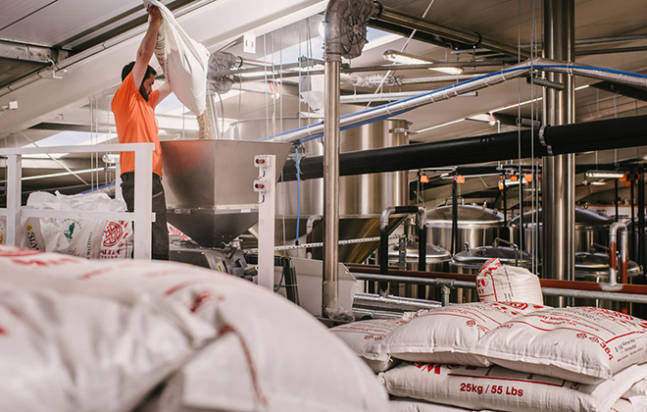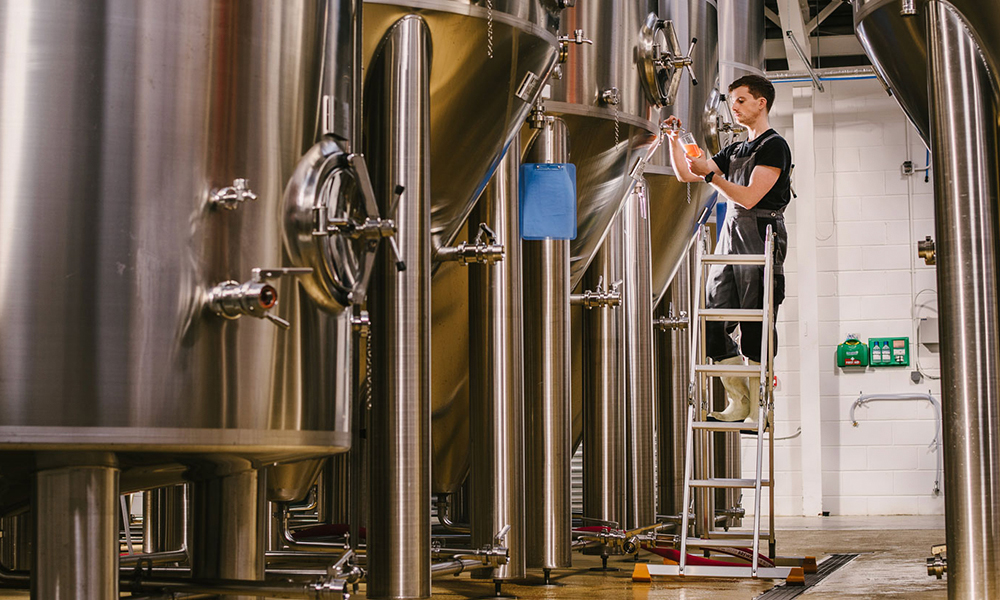Up until these past few months, the vast majority of my beer knowledge, experience, and philosophy came from my years as a homebrewer. It’s a hobby I deeply enjoy. It brings my friends together, gives me something both creative and practical to pursue, and ensures that my life has value to whatever post-apocalyptic camp I end up in as a climate refugee.
In the interest of making myself more employable in the short term, I took a three month internship at Ireland’s Kinnegar Brewing in Letterkenny, Donegal. I’ve learned a ton in my relatively short time here, with an unexpected amount being translatable to homebrewing. One of the reasons I wanted professional experience was because I kept hearing how full production was an entirely different animal. In some ways, that’s true, and even the best homebrewers aren’t cut out to be professional brewers. That said, there are definitely some homebrewing lessons to be pulled from commercial breweries, even if the homebrewer has no plans of ever going big.

Understand That You’ll Never Match Production Standards
There are a lot of considerations that commercial breweries make that would be ridiculous for homebrewers. One big one that Kinnegar’s co-founder pointed out to me is liquid expansion. At brewing temperatures, water and wort expand by three to four percent. That can mean volume differences of hundreds of liters per batch once the wort’s been cooled to fermentation temperature, and it has significant implications for a brewery’s yield estimates and gravity readings. For a homebrewer, it’s a bit of trivia. Anyone who spends their time optimizing their recipes and procedures to compensate or account for thermal expansion is a meticulous nutjob.
Put simply, any hope that a homebrewer is going to replicate the precision of a professional production should be abandoned from the outset. There are simply too many variables that it would be financially infeasible to try and control
Consider things like water chemistry, pH levels, gravity readings, and yeast health. In a production brewery, every single one needs to be measured and tracked to ensure customers get exactly the same beer every time they crack open a can or pop a bottle. One of the only ways to ensure you’re providing that is to hit the same numbers over and over. For water chemistry, strip the water of everything in it with a reverse osmosis filter, then build your profile from scratch. When pH is off, compensate with acidulated malt or lactic acid (depending on your head brewer’s sensibilities). If the wort gravity isn’t where you expect, change your sparge volumes or boil times. Track yeast health and performance consistency by counting cells, dumping dead yeast, and harvesting active yeast to transfer from batch to batch. Inconsequential details don’t really exist at the production level.
At the homebrewing level, I’ve heard of the guys who install RO filters in their houses and have thousand dollar pH probes and are obsessed with yeast harvests and starters and their optimal temperatures, and I think they’re all missing the point. I have a garden hose filter to get the really bad stuff out of my Delaware water, I’ve taken pH readings at different parts of the process to familiarize myself with the baseline, I don’t worry too much about gravity as long as I’m within 20 percent of where I want to be, and I pitch new yeast every time I brew. I’m ballparking all of this because I’m just trying to get my friends and myself a decent buzz.
Don’t get obsessive about the details. Make beer you want to drink.

Approach Cleaning Like a Professional
My patio after a brew day is a disgusting sight. There’s cooked-on foam climbing up the sides of my kettle, the boil’s protein break has congealed at the bottom, and there are buckets strewn around with bees and flies lapping up the sugary wort residue. Looking at the flotsam pushes me to indulge the worst of my procrastination. Most days, the best I can muster is dropping it all in my basement utility sink, giving the worst of it a quick rinse, and leaving. And if that kind of homebrew mess feels overwhelming, imagine the insurmountability of production brewing.
The worst I’ve had to clean up is the coconut chaos of Kinnegar’s Yanaroddy porter and 2022 Winterland stout. I’ve gotten more sincere condolences from coworkers during coconut cleanups than I’ve gotten at funerals for dead relatives.
As tempting as it is to abandon that mess to someone else or to point at it while you quit your job, the truth is that the cleanup is never actually that bad. You just chip away at the mess until it’s gone while enjoying satisfying little moments. When you’re done, you admire your handiwork and remind yourself that you could be doing something much more soul-sucking.
Cleaning my equipment at home is similar. It never takes me longer than an hour, I listen to podcasts or music the whole time I’m scrubbing, and once I’m in the thick of it, I genuinely enjoy the physicality of it. And when I’m done, I remind myself that all this cleaning enables me to share something personal with friends and family. If I could just remember that, my homebrew days would end at six instead of five and I wouldn’t have to evict mold colonies after a week of gnawing guilt. Hopefully wading through stout and slipping on coconut is the object lesson that I needed to finally solidify that lesson.

Keeping Ingredients On Hand Makes Creativity Convenient
Homebrewers often only have the malt they need as they need it. There are obvious benefits to this, like how much easier it is to organize and store individual grist bills and how some specialty malts only make sense to buy in small, exact quantities. But I’ve found only having set recipe kits means I’m lacking a certain element of creativity and spontaneity in my brewing. If I bought more grain in bulk, I’d be able to throw together new brews as the spirit moved me while also still planning my overall production schedule in advance.
This is one of the reasons I’ve enjoyed working in Kinnegar’s malt loft. Barring the most specific malt varieties, the loft has just about everything you’d need to build a good grist bill. There’s always plenty of base malt and specialty malts and adjuncts from Ireland, Germany, Britain, and Belgium. You can impulsively throw together a beer that covers a huge swath of the traditional brewing world without leaving the loft.
A good part of that availability comes from the fact that a production brewery orders grain in such quantities that there’s enough wiggle room that it’s not a problem if some grains go missing for any of the staff’s homebrewing. (Not that I’m stealing anything. Kinnegar iss very supportive of staff’s personal brewing experiments.)
Admittedly, I haven’t taken advantage of the availability too much. The job’s physical and full time, so I don’t have the time or energy to do much of my own brewing. But it’s certainly changed my philosophical approach to stocking grains. After looking at the malt loft, it makes a lot more sense in my head to absorb the initial costs of building my own malt stock. That way, I can really indulge the experimental side of my internal homebrewer.




